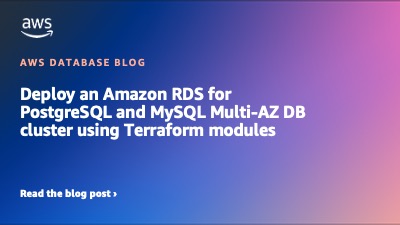AWS Database Blog
Deploy an Amazon RDS for PostgreSQL and MySQL Multi-AZ DB cluster using Terraform modules
Selecting the right cloud management tool is extremely important for many enterprises. In the post 5 Tips for Keeping Pace with AWS’s Innovation, we briefly discussed the high-level strategies to overcome the challenges of continuous improvement and drive innovations in your organization. In this post, we show how infrastructure as code (IaC) solutions built with […]
Read Scalability with Amazon Aurora Serverless v2
Amazon Aurora Serverless is an on-demand, auto scaling configuration for Aurora. It scales the capacity up or down based on your application’s needs. It enables you to run your database in the cloud without managing any database capacity. Aurora Serverless v2 supports Amazon Aurora Global Database , Multi AZ, AWS Identity and Access Management (IAM) […]
How Wiz used Amazon ElastiCache to improve performance and reduce costs
This is a guest post by Sagi Tsofan, Senior Software Engineer at Wiz in partnership with AWS. At Wiz, it’s all about scale. Our platform ingests metadata and telemetry for tens of billions of cloud resources every day. Our agentless scanner collects massive amounts of data that needs to be processed very efficiently. As our […]
Speed up database migration by using AWS DMS with parallel load and filter options
Some migrations might take a long time because they have large tables. However, AWS Database Migration Service (AWS DMS) features such as parallel load and filters might be able to help speed up this process. AWS DMS is a data migration service that has robust features for supporting both homogenous and heterogeneous database migrations. AWS […]
Amazon Managed Blockchain sessions and workshops from AWS re:Invent 2022
Engaging with the customers at AWS re:Invent is always a great opportunity for us to learn more about their use cases, get their feedback on our services, and present new features and capabilities. The Amazon Managed Blockchain team conducted a series of presentations and workshops that focused on how customers are using blockchain technology and […]
Improve application availability on Amazon Aurora
An Online Transaction Processing (OLTP) database is a key building block of a highly available application. Business-critical workloads can leverage Amazon Aurora database clusters in Multi-AZ configuration to help improve their overall uptime, and reduce the impact of availability-related events such as Multi-AZ failovers. In this post, we discuss aspects of Amazon Aurora related to […]
Use point-in-time recovery to restore an Amazon DynamoDB table managed by AWS CDK
Point-in-time recovery (PITR) in Amazon DynamoDB is a fully managed capability that creates continuous backups of your DynamoDB table data. Continuous backups are important to ensure business continuity and compliance with regulations, and to protect against human errors, such as unintended writes or deletes. When PITR is enabled for a DynamoDB table, DynamoDB automatically backs […]
Choose shard keys to optimize Amazon DocumentDB Elastic Clusters
As applications grow, data grows as well, so it’s imperative for a modern cloud-based application to have a database that can automatically scale. Amazon DocumentDB (with MongoDB compatibility) is a fully managed, native JSON database built with a flexible schema for enterprise applications that decouples storage and compute, improving scalability and reducing time-consuming administrative tasks. […]
Monitor SQL Login creation on Amazon RDS for SQL server
Maintaining database security is indispensable for the success of any organization. Implementing database user authentication and authorization is an important step in securing a database system. Conventional database authentication is based on a username-password mechanism. This process requires constant time and effort from both DBAs and end users to manage the credentials. In contrast, incorporating […]
Data modelling for an internet-scale online transactional system using Amazon DynamoDB
Relational database management system (RDBMS) technology was the preferred choice for data storage for decades. In recent years, the rise of internet-scale applications and exponential data growth have challenged the way industries have designed their database strategies. Organizations are seeing clear benefits in scalability and performance by migrating mission-critical online transactional systems built on RDBMS […]









